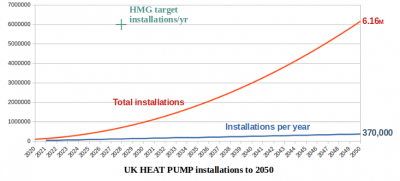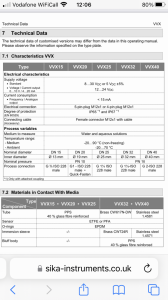Posted by: @derek-mLet's see if we can agree upon some things.
Say that at minimum operating parameters a heat pump is producing 2.5kW of heat energy, but the heat loss of the home is only 2kW. The heat pump sends out 2.5kW of heat energy, the heat emitters absorb 2kW of heat energy, and 0.5kW of heat energy is returned to the heat pump in the form of warmer RWT. Because the RWT is higher and 2.5kW of heat energy is still being supplied to the water, the LWT will increase. The higher LWT will increase the temperature of the heat emitters, who will now emit slightly more heat energy, but not 2.5kW worth.
If this situation were to continue the LWT would eventual increase to the point where the heat emitters would be emitting 2.5kW of heat energy, but the indoor temperature would also need to increase until the heat loss was 2.5kW. The system would then be in balance.
The heat pump controls do not allow the LWT to keep increasing, but stop the compressor if it gets too high. By this time the LWT is higher than it would need to be, not because it wanted to increase, but because it was forced to increase. The additional energy stored within the water and the heat emitters supplies the heat demand until the LWT falls to the point where the compressor is restarted.
The higher LWT is a consequence of the low heat demand and compressor cycling, not causing the cycling.
I think we do agree on this and I also think its consistent with what I was saying.
Looked at another way it is also necessary that there is a higher LWT in cycling mode if the heat supply from the emitters to the house is to be maintained.
So for example if I need to supply 2kW to balance the loss from the emitters to the house I can do it eg by supplying 4kW half of the time or 2kW all of the time. If the heat pump forces me to do the latter (because it doesn't modulate down sufficiently) then the only way that can happen is for the emitter temperature to be higher during the 'on' periods than it would be if I were supplying the same amount of energy on a continuous basis.
Exactly how much higher depends on the cycle time and the thermal time constant of the house (because, as you say, the circulating water will continue to lose heat to the house even when the HP is off), but higher it must be. If the time period of the cycling is very short, it wont have to be very much higher at all. if the time period of the cycling is long, it might have to be quite a bit higher.
So far as I can see, whatever way you look at it the LWT when on (in cycling mode) is higher than it is in continuous mode, and so this reduces its efficiency of the HP. John Cantor shows several examples of this in his videos.
4kW peak of solar PV since 2011; EV and a 1930s house which has been partially renovated to improve its efficiency. 7kW Vaillant heat pump.
Posted by: @jamespaPosted by: @derek-m
I think we do agree on this and I also think its consistent with what I was saying.
Looked at another way it is also necessary that there is a higher LWT in cycling mode if the heat supply from the emitters to the house is to be maintained.
So for example if I need to supply 2kW to balance the loss from the emitters to the house I can do it eg by supplying 4kW half of the time or 2kW all of the time. If the heat pump forces me to do the latter (because it doesn't modulate down sufficiently) then the only way that can happen is for the emitter temperature to be higher during the 'on' periods than it would be if I were supplying the same amount of energy on a continuous basis.
Exactly how much higher depends on the cycle time and the thermal time constant of the house (because, as you say, the circulating water will continue to lose heat to the house even when the HP is off), but higher it must be. If the time period of the cycling is very short, it wont have to be very much higher at all. if the time period of the cycling is long, it might have to be quite a bit higher.
So far as I can see, whatever way you look at it the LWT when on (in cycling mode) is higher than it is in continuous mode, and so this reduces its efficiency of the HP. John Cantor shows several examples of this in his videos.
Do you mean the former, rather than the latter?
What is the most efficient way to operate a heat pump in milder weather conditions could be dependent upon quite a number of things, the actual outside temperature, the minimum operating parameters of the heat pump, the actual design of the system, along with how the heat pump controller has been configured.
Taking your example, if the minimum continuous output of the heat pump is 2.5kW, and the heat loss is 2.5kW, but the heat pump controller is configured such that it is producing 4kW of thermal energy, then this will lead to cycling. Whether the cycling is less efficient than running continuously at an output of 2.5W, could be dependent upon how high the temperature goes and how long it takes to cool back down.
The data from my own heating system indicates that running the gas boiler, at minimum output power, for approximately 4 minutes, which is sufficient time to raise the temperature of the radiators to the low 30's, is sufficient to supply the heat loss for 1 or even 2 hours under milder weather conditions. Over the same period the indoor temperature remains within +/- 0.1C of the desired 21C. Whether it would be possible and more efficient to operate a heat pump in the same manner would need to be tested.
I suspect measuring COP accurately using heat pump controller data, may prove rather difficult, particularly under low load conditions.
Posted by: @derek-mDo you mean the former, rather than the latter?
Sorry but I'm not sure what you are referring to
Posted by: @derek-mWhat is the most efficient way to operate a heat pump in milder weather conditions could be dependent upon quite a number of things, the actual outside temperature, the minimum operating parameters of the heat pump, the actual design of the system, along with how the heat pump controller has been configured.
I completely agree, the thermodynamic argument is clear in the case of heat pumps (its different for fossil fuel boilers) but the engineering inevitably intervenes and in some, perhaps most, circumstances may dominate. Ideally of course the heat pump modulates down, but we know that there is a limit to this and so most, if not all, setups will encounter periods where the energy required is less than the minimum which can be delivered on a continuous basis. As you say the most efficient way to operate in this scenario depends on several variables, many of which are 'engineering' rather than physics, so might be difficult to quantify.
With reasonably accurate system sizing this should only matter at relatively elevated temperatures where the aggregated annual energy demand is relatively small, so it might not matter too much if the operation is not optimised. However if the system is oversized (which far too many are if the data is to be believed) it it quite likely to happen in that zone between 4C and say 12C, where our weather spends much of its time, and where the energy demand is a material fraction of the annual consumption.
In the absence of a clear strategy the clear messages for me are 'don't oversize' and 'whatever ou do make sure your system will modulate down at least to the output needed in that 'middle' region where our weather spends much of its time'. Obviously that's not much use if you already have an oversized system fitted, but it should be a serious design consideration/check for new systems which, unfortunately, it is not.
4kW peak of solar PV since 2011; EV and a 1930s house which has been partially renovated to improve its efficiency. 7kW Vaillant heat pump.
Posted by: @derek-mDo you mean the former, rather than the latter?
Sorry but I'm not sure what you are referring to
Ah, now I see, yes I meant former not the latter!
4kW peak of solar PV since 2011; EV and a 1930s house which has been partially renovated to improve its efficiency. 7kW Vaillant heat pump.
Way back at the beginning of this topic @cathoderay posted some statistics.
Posted by: @cathoderayI appreciate it is unfashionable in some circles, but I think the only way heat pumps will become mass market is by throwing money at householders in the way of substantial grants. Consider for a moment some of the figures (round UK figures):
Around 60,000 installs in 2022 (40,000 in 2021, so some growth - but for how long?)
Around 30 million households
Very roughly, if 1 million heat pumps were installed annually (one of Climate Change Committee's Dec 2020 Sixth Carbon Budget comedy targets for 2030), then it would take 30 years to get in effect all households on heat pumps. At 100,000 installations per year (perhaps where things will max out given current trends, who knows? I don't - this is just a rhetorical point) it will take 300 years.
I've been unable to locate just one source which gives those figures, but they are similar to those presented in a number of authoritative documents, including a Report from the House of Lords and a quarterly update on the Boiler Upgrade Scheme by Ofgem.
The reports vary due to when they state their marker in time. Thus 46,600 heat pumps may have been installed during 2021, but the number of 'installs per year' was obviously lower at the beginning of 2021 and higher at the end.
There is general agreement that the number of heat pump installations in UK for 2020 was around 100,000.
So although there is divergence on the later statistics, there is just enough data to show a trend.
I have therefore entered these figures into a spreadsheet and used the TREND function to forecast where this leads.
Many other factors will affect this forecast of course.
If HMG took up the suggestion from @cathoderay to remove VAT on all HPs, then it reasonable to expect that more will be installed.
Equally the number of installations will then be more significantly affected by the lack of MCS-accredited installers to do the work!
I also stretched the spreadsheet TREND function to its limits of credulity by checking when 30M houses would have a heat-pump.
The answer was 2090, rather than the 300 years which @cathoderay suggested.
But his prediction takes a more realistic view that the number of qualified installers isn't likely to continue increasing exponentially!
In conclusion I will also point out that I don't believe capital costs should be given great emphasis in suggesting why households are not having HPs installed.
If I were considering having a heat-pump, I would be asking around to hear the experiences from others who have had one installed over the past couple of years.
The two factors which would dissuade me are:
- the 'low COP', or the 'high running cost', depending on which side of the coin you're looking, and my lack of knowledge to do anything about it
- lack of trust in the installers, MCS, Building regs compliance, EPC/SAP scores
Is that fair?
Is it possibly the case that a couple of really good installers in an area could buck the national trend, merely by getting their HP installations right?
If their HPs were properly sized and the pipe insulation was correctly applied, then the savings made by their customers would create a growing waiting-list of friends and neighbours, all of whom wanted the same.
And if that hypothesis is true, then Government policy isn't going to find a solution on is own.
Save energy... recycle electrons!
Posted by: @transparentI've been unable to locate just one source which gives those figures
Sorry, should have quoted sources:
Installations: the annual numbers come from the European Heat pump Association (a trade body) and (I should have said this as well) are estimates. 2022 figure here, 2021 figure here (page 23).
Households: ONS Families and households in the UK: 2021 "There were an estimated 28.1 million households in the UK in 2021, an increase of 6.3% over the last 10 years." I added a bit to bring it up to 2023 and used a round number of 30 million.
Posted by: @transparentI have therefore entered these figures into a spreadsheet and used the TREND function to forecast where this leads.
With the greatest respect, this is pure Grade A whatiffery. But then, so too were my extrapolations. Surely the key point is that with current rates of and possible trends in installations, were are not on course for mass adoption of heat pumps, full stop. It just isn't happening.
I still think the biggest factor inhibiting uptake is capital cost. Talking informally with my friends, so not exactly a proper survey, the capital cost is invariably the number one reason for not getting a heat pump. They don't even get to investigate the market and user experience (good and bad) because they have decided against a heat pump on cost grounds alone. I should add most of these friends are on mains gas; my near neighbours, who like me are not on mains gas, are one way or another keeping their old fossil fuel system running. It will be interesting to see what they do when their boiler or just as likely oil tank reaches a point of unavoidable replacement, all the more so as they have an early adopter neighbour they can talk to (I suspect most of them won't even talk to me, because they will have ruled out a heat pumps on cost grounds alone, so they don't need to talk to anyone).
Midea 14kW (for now...) ASHP heating both building and DHW
Posted by: @cathoderayWith the greatest respect, this is pure Grade A whatiffery. But then, so too were my extrapolations.
And which is more realistic or achievable?
- your extrapolations
- my trends
- or the Government's targets?
OK, so we have differing thoughts on whether the capital outlay or long-term cost of ownership weigh most on the minds of prospective customers.
Both issues could be addressed simultaneously if a local installation company decided to:
- assemble their own ASHP units from standard components
- installed these with local controls, but off-site monitoring for trouble-shooting
- high-quality installation with attention to the detail of insulation for the house and pipework
- properly documented with a system schematic for the site, and valves/controls labelled
Is it possible they could do that without MCS accreditation and accessing the Boiler Upgrade Scheme subsidies?
Save energy... recycle electrons!
Posted by: @cathoderayI still think the biggest factor inhibiting uptake is capital cost.
Not convinced it’s just about cost. My list is worryingly long and still extending into the cold dark night.
Uncertainty at all levels! Primeval- will I feel warm? to technical- does my installer know what he/she is doing? and all the hiccups and avoidable mistakes and coverups in between.
I give you one simple example: your flow sensor.
Do you know if it gives you the correct flow reading through your heat pump? Since it’s fundamental to stopping cycling that the flow rate reading doesn’t drop below a certain threshold.
You may take it as a given that the flow readout is correct because the flashy console tells you so. However if you have 32mm pipes but only a 20mm ID flow meter fitted it’s very likely the flow rate through the heat pump is considerably over reported. Bigger bore flow meters are a lot more expensive than the more common 19mm bore but it could also be that the installer just collects what’s available on the stock shelf.
Another problem with an undersized flow meter is the impact on constricting the 32mm flow and it’s contribution to the resistance in the pipework which is another cause of cycling.
(Unless someone can tell me that a 15 LPM Flow rate through a 20mm bore sensor is the same flow rate through the connected 32mm primaries? Then this is yet another fundamental installer error)
In the quest for “what do we need to know” I’m thinking we need another topic called “what does the homeowner need to know before investing in a heat pump” since much of the resistance to getting one installed is the uncertainty of whether it will do the job trouble free.
I’ll attach a picture of all the Sika Vortex flow sensors with the internal pipe diameters available.
The main installation leaflet that comes in the box does not mention anywhere in the text the relevance of the bore size.
The flow rate through 15mm pipework will indeed be the same as through 28mm pipework, since it is the quantity that is being measured. The flow velocity will be higher in the 15mm pipework, but not the quantity.
Posted by: @sunandair(Unless someone can tell me that a 15 LPM Flow rate through a 19mm bore sensor is the same flow rate through the connected 28mm primaries? Then this is yet another fundamental installer error)
not sure what you mean by installer error, but flow rate as a volume per unit time doesn't change if your pipe gets bigger or smaller as you go along a run. the flow velocity will be different - faster in the smaller pipe.
the smaller meter will may constrain the flow somewhat i.e. contribute to making the overall flow rate slower - But if its not a very long section, the effect of that is usually negligible.
what might be the issue is that the meter may have different accuracy and measuring parameters depending on its size, this is where expertise in metering is needed .
My octopus signup link https://share.octopus.energy/ebony-deer-230
210m2 house, Samsung 16kw Gen6 ASHP Self installed: Single circulation loop , PWM modulating pump.
My public ASHP stats: https://heatpumpmonitor.org/system/view?id=45
11.9kWp of PV
41kWh of Battery storage (3x Powerwall 2)
2x BEVs
I think we went through the "what can puts people off heat pumps" in another thread and came to a reasonable consensus
- capital cost
- (potentially) high run cost
- difficulty to find an installer who is 1) reputable / proven record / knowledgeable 2) available and actually wants to quote 3) local
- aftercare (will performance be what it was quoted and designed to be to be, how is that assured and checked / monitored, how is it remediated if not)
My octopus signup link https://share.octopus.energy/ebony-deer-230
210m2 house, Samsung 16kw Gen6 ASHP Self installed: Single circulation loop , PWM modulating pump.
My public ASHP stats: https://heatpumpmonitor.org/system/view?id=45
11.9kWp of PV
41kWh of Battery storage (3x Powerwall 2)
2x BEVs
- 26 Forums
- 2,356 Topics
- 53.4 K Posts
- 255 Online
- 6,017 Members
Join Us!
Worth Watching
Latest Posts
-
RE: Octopus Cosy Heat Pump Owners & Discussion Thread
@kevh with the Cosy 6 I know it definitely goes to arou...
By HarrisonC , 43 minutes ago
-
RE: Setback savings - fact or fiction?
@cathoderay yes I am familiar with SQL. Interesting num...
By RobS , 2 hours ago
-

Parsnip, Bacon & Coconut Milk Soup
First let me say, I am only a cook because I am human a...
By Toodles , 2 hours ago
-

RE: Controlling Daikin Altherma via P1P2 and Home Assistant
@weoleyric Oh Dear, I don’t think I am going to be of m...
By Toodles , 2 hours ago
-
RE: Electricity price predictions
Ben Watts posted on LinkedIn that he had updated this w...
By Judith , 7 hours ago
-

RE: The good, the bad and the not that great – my heat pump installation
Small update, Emailed and Spoke to Midea UK and they ...
By Burtis , 8 hours ago
-
RE: Solis S6-EH1P8K-L-PLUS – Why I Chose It and What I’ve Learned So Far
@bash Octopus does charge for the admin. The process al...
By Batpred , 8 hours ago
-
RE: External pipework insulation
@transparent HI all The products you mention are ver...
By David Smith , 8 hours ago
-
RE: New Fogstar 15.5kWh upright solution
Issues still under investigation by Solis... Fogstar ...
By Batpred , 8 hours ago
-
RE: Who's your electricity provider and what's your tariff?
I agree, the consumer is not being properly represented...
By Batpred , 8 hours ago
-
RE: Advice on internal circulation pump noise
Thanks @mikefl - I'll maybe have a look at the lock-shi...
By jtg , 1 day ago
-

RE: Heat Pump Heats the House… But It’s Not Cosy. Emitter Changes or System Tweak?
@toodles interesting suggestion, thanks. I will try to...
By GrahamF , 1 day ago
-
RE: Mitsubishi Ecodan Auto Adaption trial to stop cycling.
The interval you talk of, i think, will be 60min for an...
By F1p , 1 day ago
-
Agree with @majordennisbloodnok on the setbacks. We hav...
By ChandyKris , 2 days ago
-

RE: Speedcomfort radiator fans
@deltona the way the links were added broke the page. A...
By Mars , 2 days ago
-

RE: Refrigerant R32, is it now banned in the EU from 1st Jan 2027 for monobloc ASHPs?
This has been delayed from what I believe to be this ye...
By dgclimatecontrol , 2 days ago
-
RE: Are We Sleepwalking Into Another Race to the Bottom?
this is why I provided current flow temperatures in the...
By ksim , 2 days ago
-

RE: Why Millions of UK Homes Struggle With Heat Pumps
There's many homes that would be quite a disruption for...
By dgclimatecontrol , 2 days ago
-
RE: Ecodan unable to hit legionella target temp - what's the consensus?
@rhh2348 ...maybe this option is what you want? Alter...
By benson , 2 days ago







